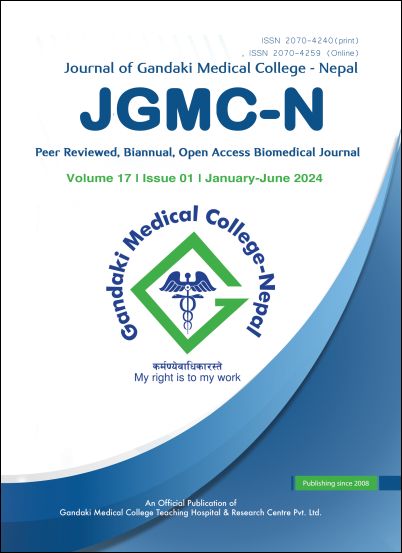Stethoscopes: A potential source of hospital-acquired infection of methicillin-resistant Staphylococcus aureus
DOI:
https://doi.org/10.3126/jgmcn.v17i1.64396Keywords:
Antibiotic resistance, methicillin-resistant, Staphylococcus aureus, stethoscopeAbstract
Introduction: The stethoscope, an essential tool for medical examination, can be an important vehicle for the transmission of drug-resistant pathogens like methicillin-resistant Staphylococcus aureus. Thus, this study aimed to detect the stethoscope as a potential source for hospital-acquired methicillin-resistant Staphylococcus aureus infection.
Methods: This descriptive cross-sectional study was carried out from January to February, 2023 in the Department of Microbiology by collecting swab samples from medical interns’ stethoscopes. Ethical clearance from the Institutional Review Committee was obtained (Ref. No. 139/078/079). Staphylococcus aureus were isolated and methicillin resistance was detected using cefoxitin disc following Clinical and Laboratory Standards Institute guidelines. Consecutive nonprobability sampling was used. Data analysis was done using a Statistical Package on Social Sciences version 26.0.
Results: From a total of 103 swabs, 89(86.40%) showed growth, among which 41(46.10%) were identified as Staphylococcus aureus. Out of 41, Staphylococcus aureus identified, 13(31.7%) were methicillin-resistant. Methicillin-resistant strains were mainly isolated from emergency and intensive care units, 3(23.1%). More than fifty percent of the strains were resistant to azithromycin, ciprofloxacin, and ofloxacin. None of the strains were resistant to linezolid.
Conclusions: Detection of methicillin-resistant Staphylococcus aureus on the stethoscope used by medical interns working in critical areas of our institution is of utmost concern. This basic data is an eye opener for vigilance surveillance and practicing of disinfecting stethoscopes and hand hygiene among health workers in health care centers.
Downloads
Downloads
Published
How to Cite
Issue
Section
License
Copyright (c) 2024 The Author(s)

This work is licensed under a Creative Commons Attribution-NonCommercial 4.0 International License.
This license allows reusers to distribute, remix, adapt, and build upon the material in any medium or format for noncommercial purposes only, and only so long as attribution is given to the creator.




